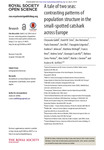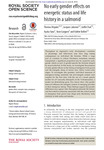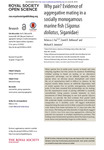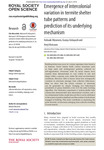Search
Now showing items 1-10 of 67
Can outcomes of dyadic interactions be consistent across contexts amongwild zebrafish?
(The Royal Society, 2015)
Winner–loser relations among group-living individuals are often measured by the levels of aggressive interactions between them. These interactions are typically driven by competition for resources such as food and mates. ...
A tale of two seas
(2014)
Elasmobranchs represent important components of marine ecosystems, but they can be vulnerable to overexploitation. This has driven investigations into the population genetic structure of large-bodied pelagic sharks, but ...
Repeatability in the contact calling systemof Spix’s disc winged bat
(2015)
Spix’s disc-winged bat (Thyroptera tricolor) forms cohesive groups despite using an extremely ephemeral roost, partly due to the use of two acoustic signals that help individuals locate roost sites and group members. While ...
Light-emitting diode street lights reduce last-ditch evasivemanoeuvres by moths to bat echolocation calls
(The Royal Society, 2015)
The light-emitting diode (LED) street light market is expanding globally, and it is important to understand how LED lights affect wildlife populations. We compared evasive flight responses of moths to bat echolocation calls ...
Discrete but variable structure of animal societies leads to the false perception of a social continuum
(2016)
Animal societies are typically divided into those in which reproduction within a group is monopolized by a single female versus those in which it is shared among multiple females. It remains controversial, however, whether ...
Artificial light onwater attracts turtle hatchlings during their near shore transit
(2016)
We examined the effect of artificial light on the near shore trajectories of turtle hatchlings dispersing from natal beaches. Green turtle (Chelonia mydas) hatchlings were tagged with miniature acoustic transmitters and ...
No early gender effects on energetic status and life history in a salmonid
(2015)
Throughout an organism’s early development, variations in physiology and behaviours may have long lasting consequences on individual life histories. While a large part of variation in critical life-history transitions ...
Why pair? Evidence of aggregativemating in a sociallymonogamous marine fish
(The Royal Society, 2015)
Many species live in stable pairs, usually to breed and raise offspring together, but this cannot be assumed. Establishing whether pairing is based on mating, or an alternative cooperative advantage, can be difficult, ...
Omura’s whales off northwest Madagascar
(2015)
The Omura’s whale (Balaenoptera omurai)was describedas a new species in 2003 and then soon after as an ancient lineage basal to a Bryde’s/sei whale clade. Currently known only from whaling and stranding specimens primarily ...
Emergence of intercolonial variation in termite shelter tube patterns and prediction of its underlying mechanism
(2015)
Building behaviours occur in various organisms from bacteria to humans. Social insects build various structures such as large nests and underground galleries, achieved by self-organization. Structures built by social insects ...










